On the sign:
[תמונה]
נשות בית האמהות בטיול בכותל בסוף שנות השישים.
למטה יושבות ראשונה מימין בת שבע גדליהו, שניה מימין מזל קשי; באמצע יושבת שניה משמאל חנה קלתי; למעלה עומדות שניה משמאל מרים ישראלי, שלישית משמאל מרים מורדוף
בית האמהות
בבנין זה שכן בית אמהות של קהילת אנוסי משהד בישראל. בשנת 1950, הקימה קבוצת נשים שעלתה ממשהד לישראל, את ועד עזרת נשים לקהילת אנוסי משהד, שבאמצעותו נאספו תרומות מבני הקהילה בארץ ובחו"ל. הנשים המייסדות היו: בת שבע גדליהו, חנה קלתי, מרים מורדוף, מרים ישראלי וצביה חכימי.
מכספי התרומות נרכש מבנה בלב שכונת נווה צדק בתל אביב , בפינת הרחובות רוקח ושלוש , ובשנת 1958 נחנך כאן לראשונה בית האמהות עזרת נשים לקהילת אנוסי משהד . ברבות השנים נרכשו גם המבנים הסמוכים , ובית האמהות התרחב לשלושה מבנים צמודים , בהם התגוררו בצוותא עשרות קשישות מבנות הקהילה , אשר חילקו ביניהן את מלאכות הבית וטופלו במסירות בידי הנשים המייסדות , שאליהן הצטרפו מתנדבות נוספות מבנות הקהילה , ביניהן מזל קשי , חנה כרמלי , לאה אגיוף , מרים סולימני , זילפה כהן , דבורה רחימי , ועוד . הפרויקט החלוצי שיזמו נשים אלה מהווה מודל והשראה לסולידריות נשית .
בית האמהות פעל באתר זה עד 1992 , אז נמכר ובתמורה הכספית , בשילוב עם תרומות נדיבות מבני קהילת אנוסי משהד בארץ ובתפוצות , הוקם בית אבות מפואר ליהודי משהד ולכלל הציבור בהרצליה פיתוח, הפועל עד עצם היום הזה תחת השם "בית אבות לאנוסי משהד" , עם הקמת בית האבות , הועברו אליו גם דיירות בית האמהות.
Mothers’ Home
This building was formerly Beit Imahot (Mothers’ Home - Home for aged women) of Mashadi Jews in Israel. In 1950, a group of women who immigrated from Mashad to Israel established a women’s steering committee for the Mashadi Jews in Israel, collecting donations from community members in Israel and abroad. The founding members were: Bat Sheva Gedalyahu, Hanna Kelati, Miriam Moradoff, Miriam Israeli and Tzvia Hakimi.
Using donated money, they purchased a building in Tel Aviv, on the corner of Shimon Rokah and Shlush Streets. In 1958 the Ezrat Nashim Beit Imahot (Mothers’ Home) for the Community of Mashadi Jews in Israel was established here. With time, neighboring buildings were also purchased. Beit Imahot was expanded into three adjacent buildings, where dozens of the communitys elderty women resided, sharing household chores. They were devoutly cared for by the founding members, along with additional community members including Mazal Kashi, Hanna Carmeli, Lea Aggaioff, Miriam Sulemani, Zilpa Cohen, Devora Rahimi and others. This pioneering project initiated by these women is a model and a source of inspiration for women’s solidarity.
Beit Imahot remained on this site until it was sold in 1992. The revenue from the sale of the building. together with additional generous donations from community members in Israel and abroad, enabled the establishment of the Old Age Home for Mashadi Jews in Herzliah Pituach to which the residents of Beit Imahot moved.
[תמונות]
שער הכניסה לבית האמהות, צילום: חוני המעגל
המבנה ההסטורי של בית האמהות ברחוב רוקח פינת שלוש. איור: אדריכל סרג’יו לרמן
מפגש נשים בחצר בית האמהות, צילום: חוני המעגל
ארוע חגיגי בבית האמהות
סמל קהילת משהד
סמל המועצה לשימור אתרי מורשת בישראל
[שלט שני]
[תמונות]
יוסף וזולייכה לג’אמי, הסופר: אליהו בן ניסאן בן אליה (אלג’ורג’י), אירן, משהד, תרי"ג 1853, אוסף בית המדרש לרבנים, ניו יורק.
כתובה יהודית, איראן, משהד, 1853, אוסף רוברט מרדצ’ה, ארה"ב
קהילת משהד
"אנוסי משהד" היא קהילה יהודית מהעיר משהד שבצפון אירן , שהיתה אנוסה לקבל עליה את דת האסלאם במשך 120 שנה, אך שמרה על יהדותה בסתר .
משהד הינה אחת הערים הקדושות ביותר לשיעים בעולם , ובה קבור האימאם השיעי, "אימאם רזא". עד המאה ה - 18, נחשבו היהודים באירן טמאים ועל כן נאסרה עליהם הכניסה למשהד.
בשנת 1737, רמטכ"ל צבא אירן נאדר חאן, שהיה מוסלמי סוני ורחש אמון ליהודים, הזמין כארבעים משפחות יהודיות מהעיר קזווין להתגורר בעיר קלאת, כדי שיסייעו בידו לשמור על השלל שהביא מהודו בשובו ממסע כיבושים. לימים הומלך נאדר חאן למלך, קבע את משהד כבירתו והעביר אליה את היהודים, אך ב - 1747 נרצח בידי קנאים שיעים והשיעים עלו לשלטון.
יהודי העיר משהד, שנותרו ללא הגנת השלטון, קבעו את משכנם בשכונת "עידגה" שמחוץ לחומות העיר, חיו בפחד מתמיד וחוו פרעות והתנכלויות על רקע קנאות דתית מצד שכניהם המוסלמים.
בערב פסח התקצ"ט (אפריל 1839) העלילו השיעים הקנאים על יהודי העיר עלילת דם ובעקבותיה פרצו בעיר מהומות ומאורעות שבהם ביצעו המוסלמים מעשי טבח וביזה ביהודי משהד.
כוהני הדת המוסלמים כפו על היהודים "מוות או אסלאם". יהודי משהד ששרדו את הפוגרום, נאנסו לקבל עליהם את דת האסלאם וכונו "ג’דיד אל אסלאם" (המוסלמים החדשים). הם בחרו לחיות כלפי חוץ כמוסלמים, תוך שמירה על מצוות הדת היהודית במחתרת, באדיקות ובחירוף נפש.
בתחילת המאה העשרים, החלו בני הקהילה לעזוב את משהד. לאחר פוגרום נוסף בשנת 1946, עזבו את העיר מרבית תושביה היהודים והקימו קהילות משגשגות בערים מרכזיות בארץ ובעולם ובעיקר בלונדון, במילנו, בהמבורג ובניו יורק.
יהודי משהד שעלו לארץ הקימו בה ועד פעולה, אגודות ומוסדות לסיוע הדדי וגמילות חסדים לחברי הקהילה, והקימו בתי כנסת רבים.
Mashad Community
"Anusei Mashad" is a Jewish community of the holy city of Mashad in north Iran. They were forced to accept Islam for 120 years, but secretly continued to practice Judaism.
Mashad was considered one of the holiest cities to Islam, as Imam Reza was buried there and so Mashahdi Jews were considered unclean, and were not accepted to the city.
In 1737 Nader Khan, Iran’s illustrious general, and later on Nader Shah, (King Nader) invited a group of Jews to the city of Mashad. Trusting highly the Jews, the Khan invited them for the purpose of managing the king’s treasury.
In 1747 Nader Shah was assassinated. Mashadi Jews were now devoid of government protection and exposed to riots and harassments from their Moslem neighbors. Mashad, a sacred city for the Shite Islam, was known for its religious zeal.
On the eve of Passover 5,599 (April 1839), the zealous Shiites spread a blood libel against them, followed by pogroms in which the Moslems massacred and plundered Mashadi’s Jews. The Jews were forced by the Islamic mullahs to choose "Death or Islam", and so, Mashadi Jews were coerced to convert to Islam. They chose to live as Moslems in the outside world, while strictly and bravely keeping the Jewish religion in the underground, albeit being endangered by their Moslem neighbors.
In the early 20th-Century the communitys members started leaving Mashad, and after another pogrom in 1946, most of Mashad’s Jewish residents immigrated to major world cities, in which they established thriving communities. Mashhadi Jews who immigrated to Israel founded a steering committee, associations and institutions for mutual help and chárity, as well as many synagógues.
[תמונות]
ארגז פרשות, משהד, איראן, עץ נייר וכריכות עור, ניו-יורק ארה"ב
תפילים זעירים, איראן, משהד, אמצע המאה ה-19, עור וקלף. אוסף יעקב נאמדאר, ארה"ב
סמל קהילת משהד
סמל המועצה לשימור אתרי מורשת בישראל
Comments:
The following pictures enlarge parts of the sign
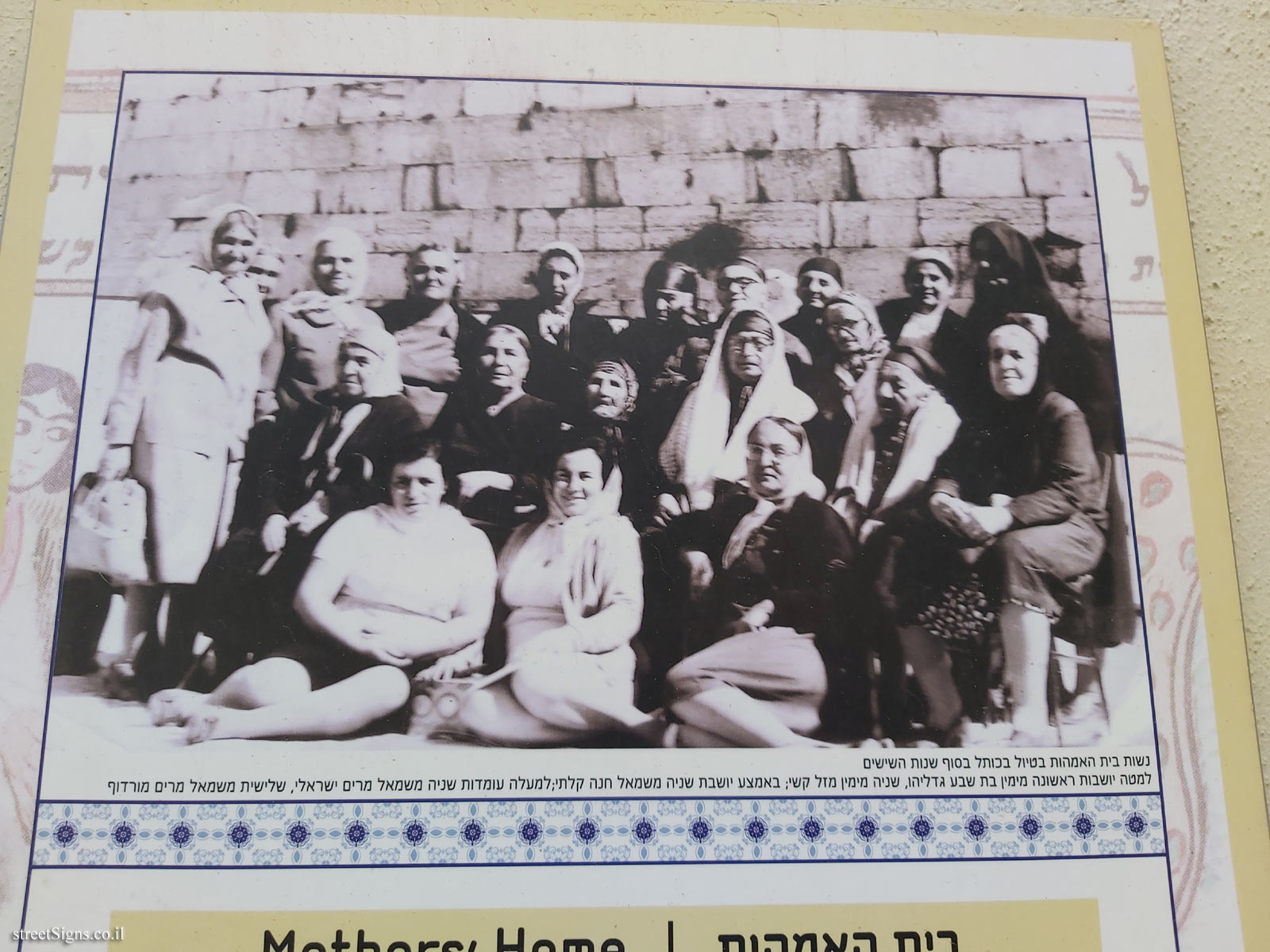 Click for a larger image
Click for a larger image 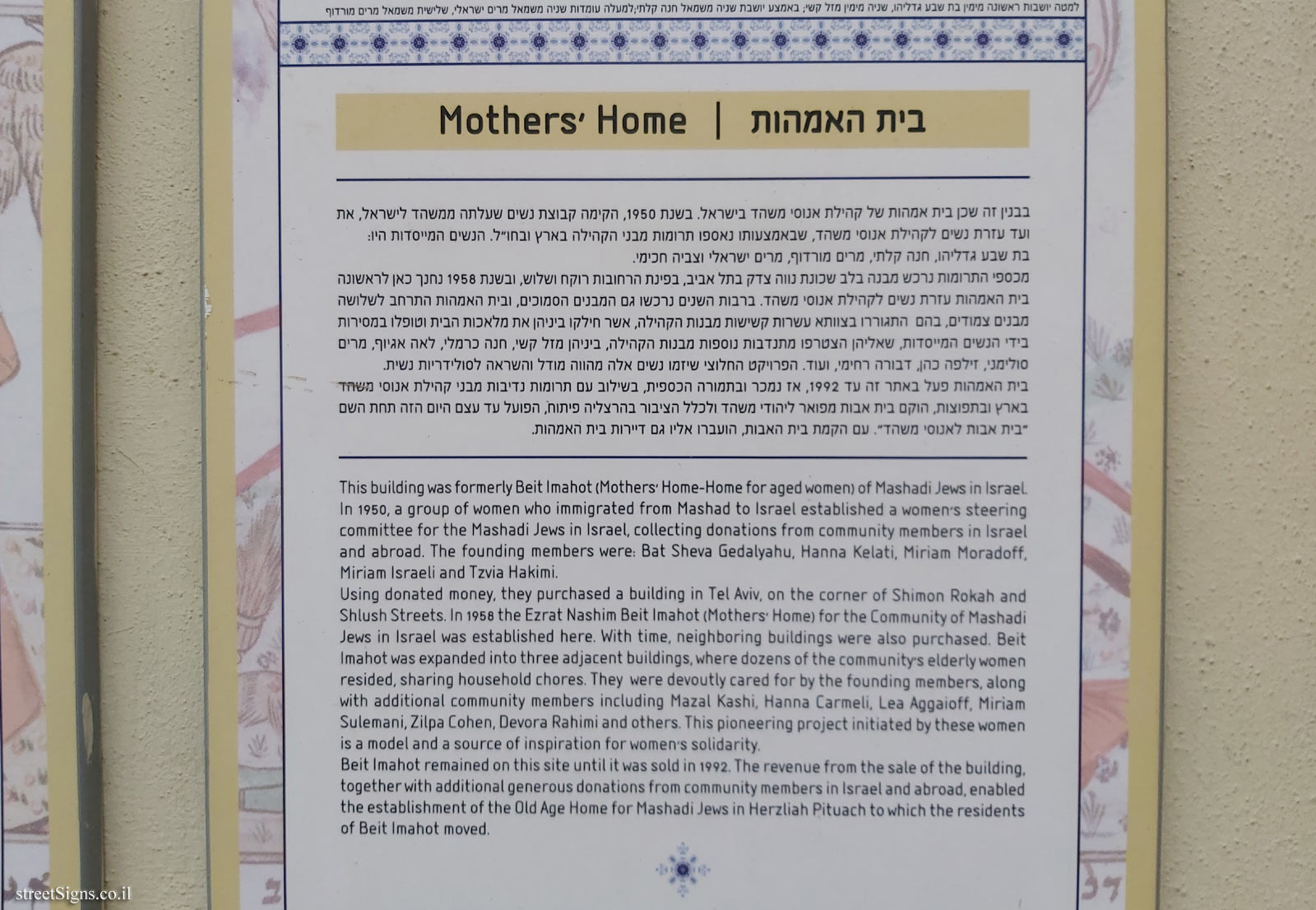 Click for a larger image
Click for a larger image 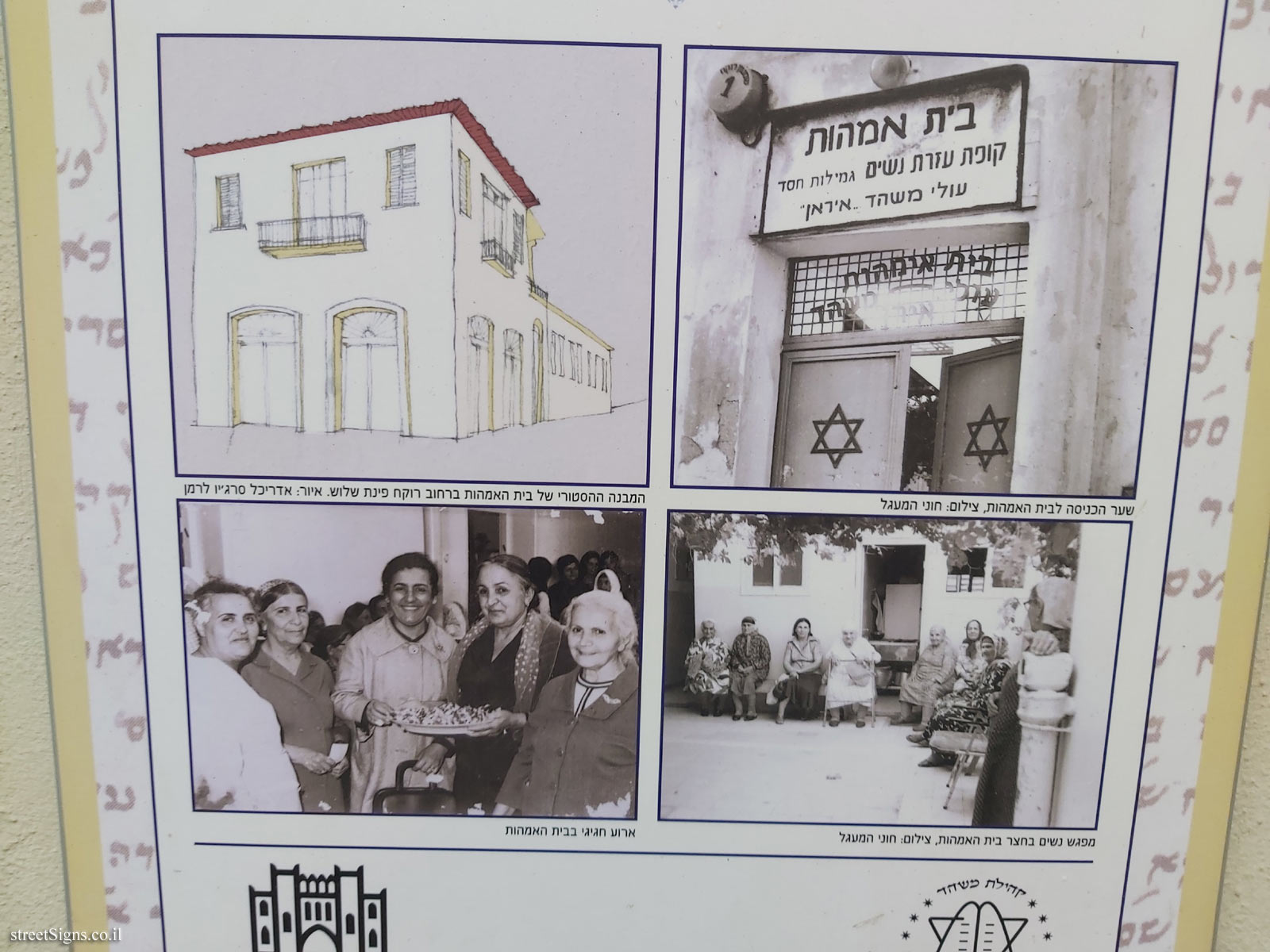 Click for a larger image
Click for a larger image 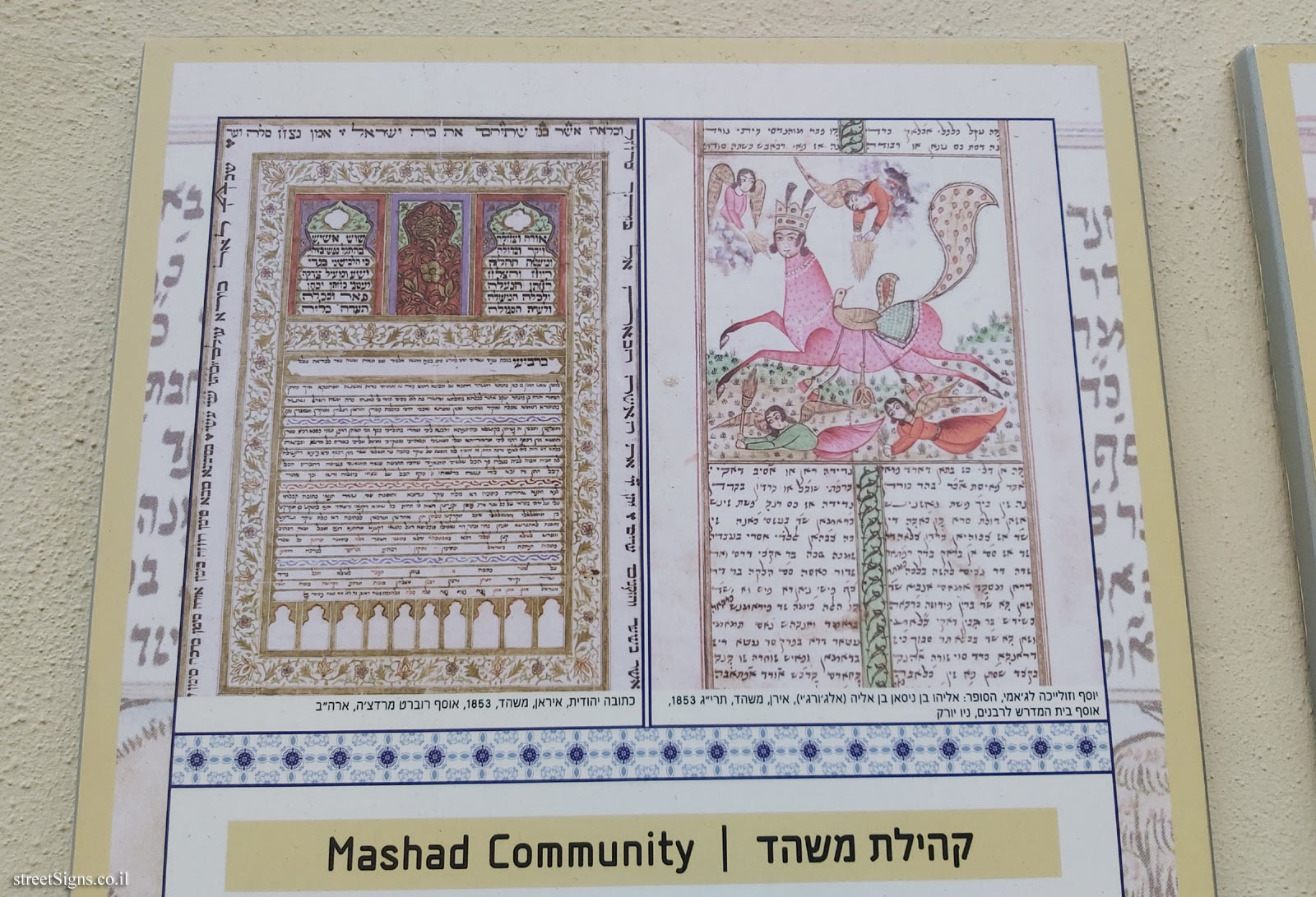 Click for a larger image
Click for a larger image 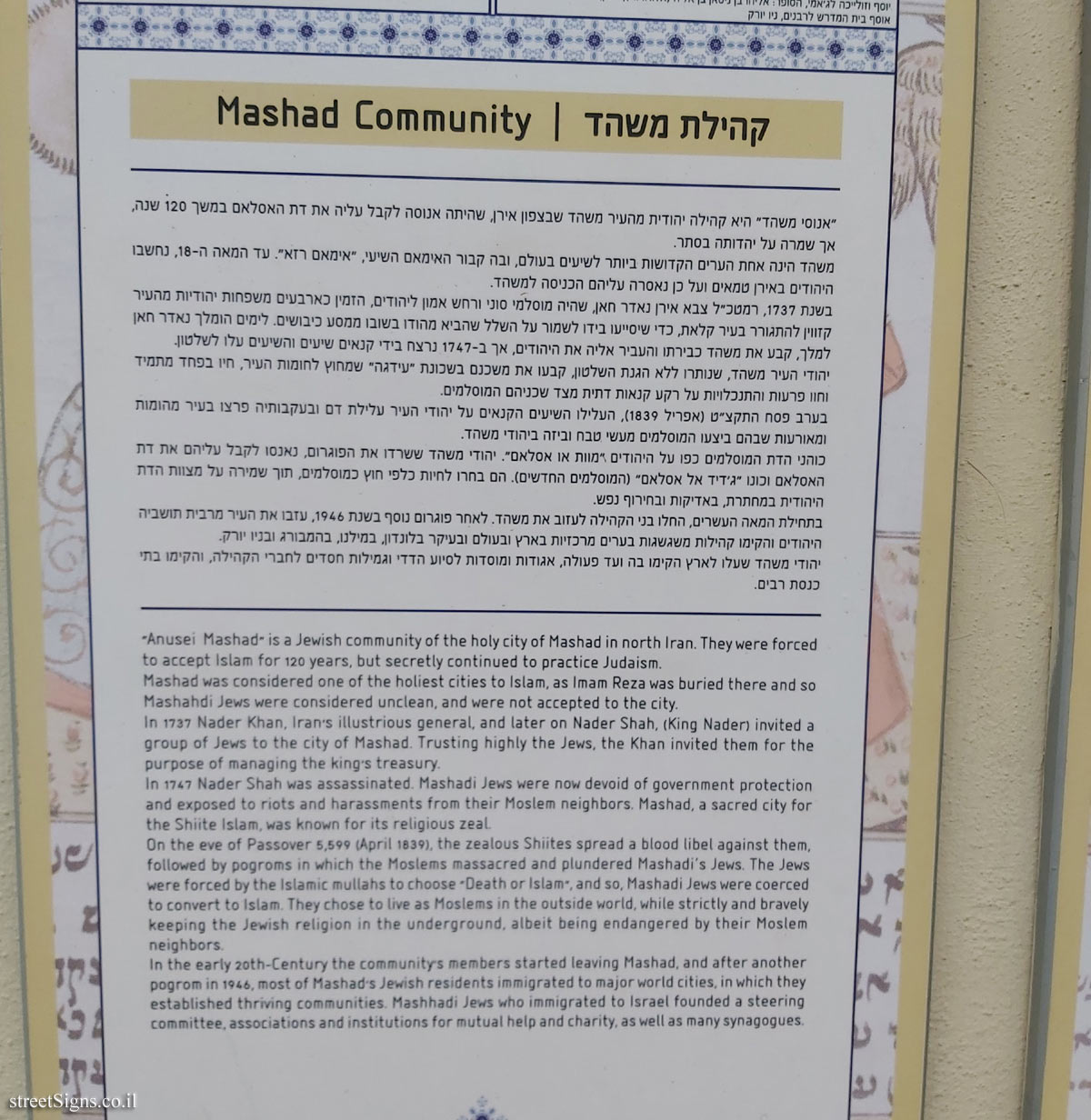 Click for a larger image
Click for a larger image 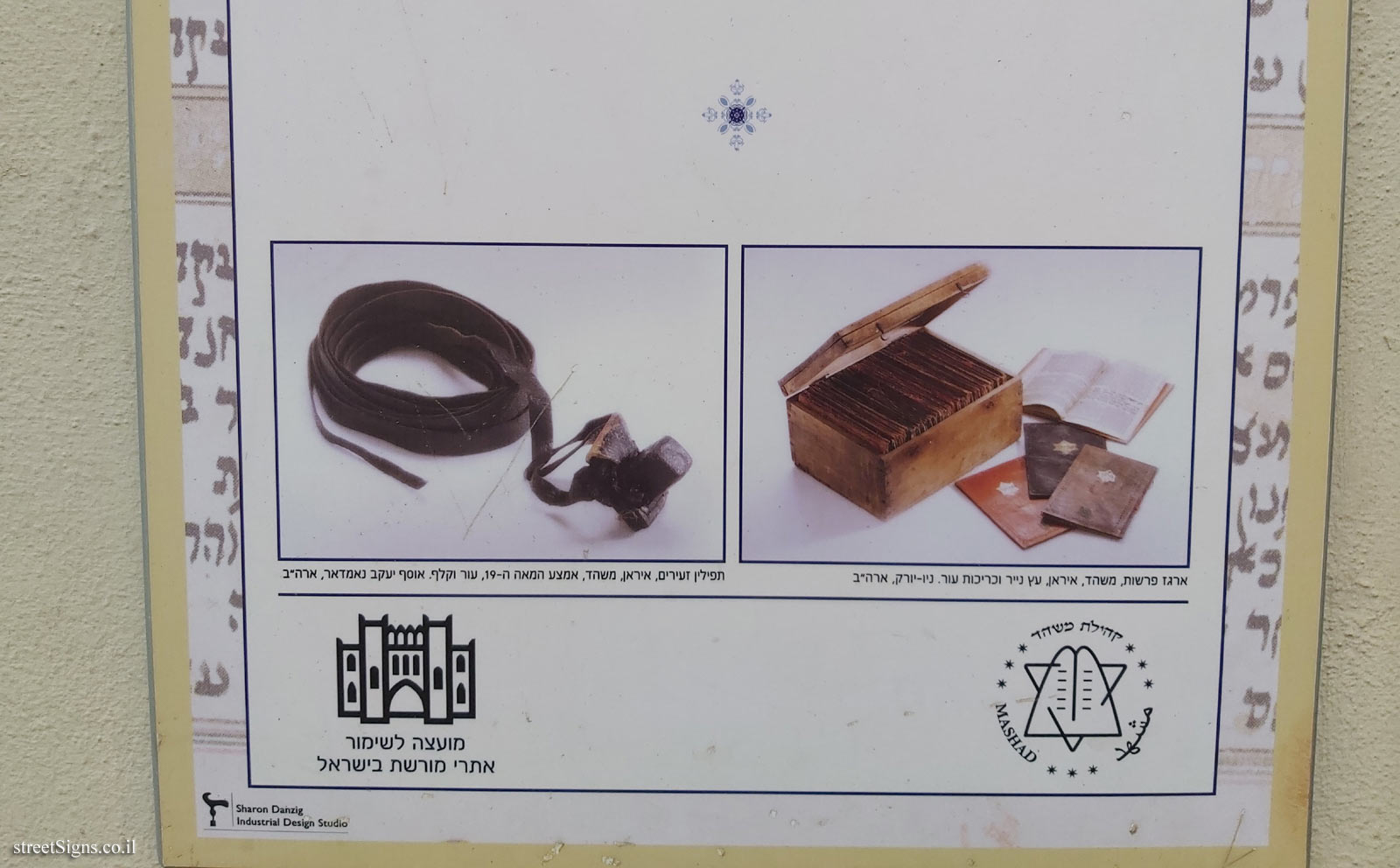 Click for a larger image
Click for a larger image The mothers’ house and the signs on it were taken on the day the signs were taken
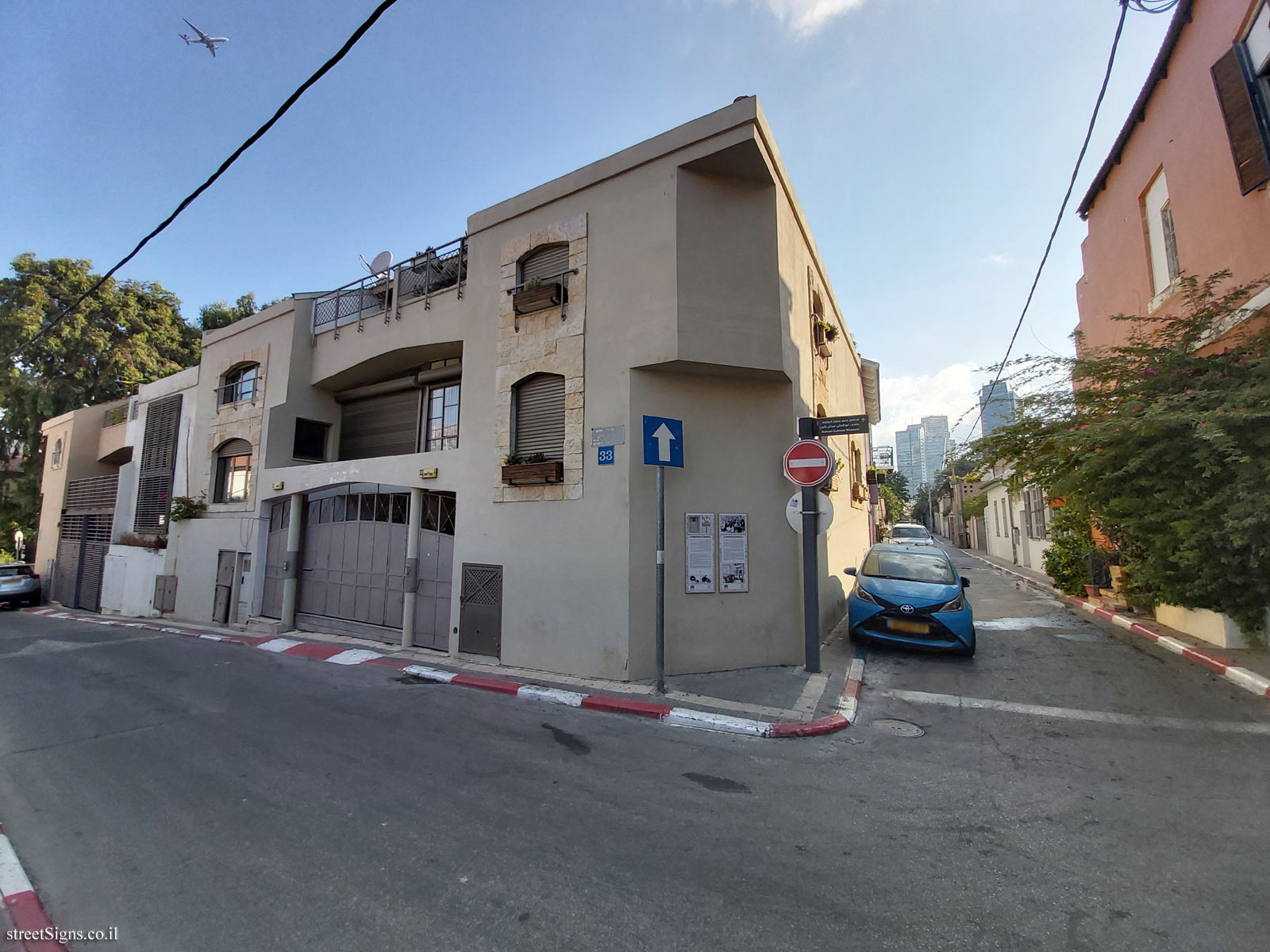 Click for a larger image Translation of the text on the sign
Click for a larger image Translation of the text on the sign:
[Image]
Wives of the Mothers’ House on a trip to the Western Wall in the late 1960s.
Downstairs are the first on the right Bat Sheva Gedaliah, the second on the right is Mazal Kashi; In the middle sits a second to the left Hana Kalati; On top are second from the left Miriam Israeli, third from the left Miriam Mordoff
[Pictures]
Entrance gate to the mother’s house, Photo: Honi HaMagal
The historic building of the Mothers’ House on Rokach Street Corner of Shlush. Illustration: Architect Sergio Lerman
Meeting of women in the courtyard of the mothers’ house, Photo: Honi HaMagal
Festive event at the mothers’ house
Community Icon of Mashhad
Symbol of the Council for the Preservation of Heritage-Sites in Israel
[Second sign]
[Pictures]
Joseph and Zulayka Lajami, Author: Elijah Ben Nissan Ben Elia (Algeria), Iran, Mashhad, 1853, Collection of the Rabbinical Seminary, New York.
Jewish Scripture, Iran, Mashhad, 1853, Robert Mardecche Collection, USA
[Pictures]
Case Box, Mashhad, Iran, Paper Wood and Leather Covers, New York USA
Tiny prayers, Iran, Mashhad, mid-19th century, leather and parchment. Jacob Namdar Collection, USA
Community Icon of Mashhad
Symbol of the Council for the Preservation of Heritage-Sites in Israel

 Click for a larger image
Click for a larger image  Click for a larger image
Click for a larger image  Click for a larger image
Click for a larger image  Click for a larger image
Click for a larger image  Click for a larger image
Click for a larger image  Click for a larger image
Click for a larger image  Click for a larger image
Click for a larger image